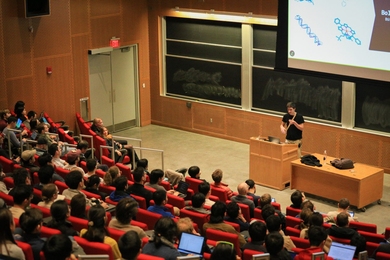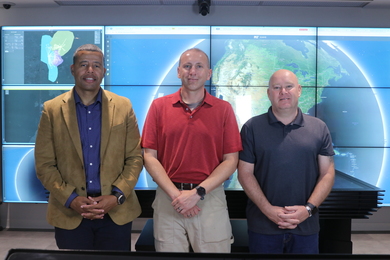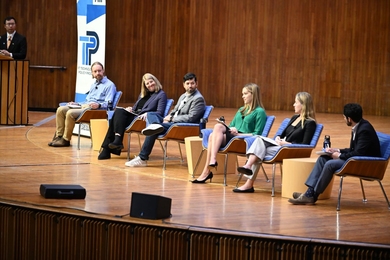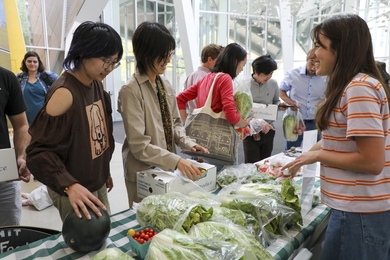Junior Summit '98, a weeklong conference for children to explore and realize their visions of future possible uses of technology, ended on an anthemic note as 94 young participants from around the world presented their ideas to a standing-room-only crowd in Kresge last Saturday.
Using computer graphics, images, text and the power of their own voices, the young people outlined their step-by-step plans to change the world.
Their generation -- now known as the digital generation -- would all belong, they declared, to Nation1, a cyber-country where anyone under 19 is automatically a citizen. They would found and fund a Kidz Bank, an on-line bank that could lend money for other innovative projects. And they would establish an on-line global magazine, written and designed by young journalists.
With these resources, the digital generation would improve the environment, reduce child labor, feed the hungry, ease the burdens and frustrations of the disabled, and make computers universally available.
Eager applause from the mostly adult audience greeted each presentation. The summit, hosted by the Media Laboratory, also offered a series of workshops for parents during the Cambridge segment of the conference. Judging by the constant bursts of bright light, it seemed every proud family member kept a finger on the flash or video camera.
Camera crews from CNN, Nickelodeon, NECN, WBZ-TV, NHK-TV (Japan) and RAI-TV (Italy) added their lights to the Kresge event. They were joined by radio reporters from BBC Radio4 (England) and MDR, DLF Radio (Germany) as well as local, national and international newspapers and magazines covering the summit.
The morning was more than a celebration of hope and youth and yet-to-be-invented technology, though. Midway through the event came a momentous announcement: Isao Okawa, chairman of Sega Enterprises (which makes Nintendo, among other games) and CSK Corp., which makes business software, committed $27 million to build a Center for Future Children next door to the Media Lab on Ames Street (see story above).
Looking back on the day and the week, Justine Cassell, director of Junior Summit '98 and assistant professor at the Media Lab, wondered aloud, "Will it change the world? It already has. Their energy is infectious. Their ideas are wonderful. By their process they have demonstrated the future. They're taking technology in hand and using it to make the world better."
An article in the New York Times described the vitality and power of Junior Summit '98 by analogy: the Media Lab forum was to the quaint old Model United Nations as a personal computer is to an abacus.
The summit was "beyond anything I've seen," said executive director Annette Tonti. "The diversity of kids and their respect for one another was remarkable."
The polished presentations on Saturday were hard to envisage at mid-week, when the Media Lab hosted an international press conference for the 94 summiteers and every square inch of the four-story, cube-shaped building designed by I.M. Pei seemed occupied by groups of young teenagers or adults toting TV equipment or both.
That day -- it was Thursday -- began like all the others, with a gathering in Bartos Theater to hear from various groups on the status of their projects and to recap the previous day's events.
But it quickly developed into a multifaceted media event. For one thing, TV, radio and print reporters from all over the world -- each with a goal and a deadline -- hovered about, ratcheting up the already high adrenalin.
For another, Nicholas Negroponte, director and co-founder of the Media Lab, presented the group with a celebrity challenge on who would serve as master of ceremonies for Saturday's big event. Names including Vice President Al Gore, First Lady Hillary Clinton, Secretary of State Madeleine Albright and even Michael Jordan had been conjured. And now, a more exciting opportunity was theirs.
They would choose their own master of ceremonies, from among their peers. They would have to make their own celebrities.
"I'd like to make the adult presence on stage to be as close as possible to zero," declared Mr. Negroponte, who then went on to provide tips from his own experience on how to handle the media effectively.
But the digital generation seemed fully prepared for that. Following lunch (McDonald's with side dishes of rice and vegetables), the participants acceded to round upon round of interviews, chatting easily with adults about their plans. The cable-cluttered intimacy of spaces such as the Cube worked to create a definite "Our World" experience in the Media Lab.
And the ideas kept flowing. In small groups and large, the Junior Summit participants kept up a twin refrain, "What if?" and "Why not?" With summit sponsors behind them, particularly LEGO, Swatch, and Citibank, and the Center for Future Children ahead, this week's conference set a promising stage.
The first Junior Summit was held in 1995 in Japan. Junior Summit '98 actually began a year ago, with a global invitation to children between the ages of 10 and 16 to describe their current world and to suggest ways technology might be used to improve that world.
An on-line forum which began in September connected about 3,000 children from more than 130 different countries via e-mail. Thanks to new translation technology, this group was able to work together to create the agenda for the week at MIT and to select the 100 delegates who spent the week here.
A version of this article appeared in MIT Tech Talk on November 25, 1998.






